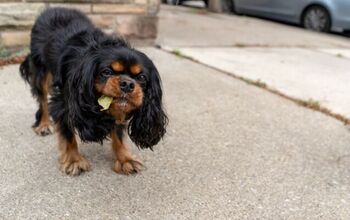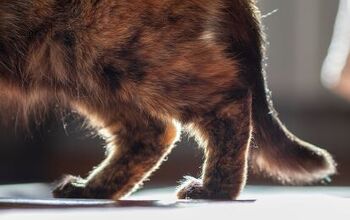How Do I Stop My Dog From Digging up My Yard?

Have you recently stepped out into your yard to find little potholes all over the place? Before you run to Google to search for products to stop your dog from digging holes (there are plenty of companies that are more than willing to take your money), let’s start with understanding the basics.
Spoiler alert: When dealing with a dog behavioral problem, a quick solution is rarely something that will last over time.
In this article, we will look at why your dog has been digging holes in the yard and how you can prevent it without giving into the deterrent sprays and other aversive products offering big promises.
Which Dog Breeds Are Prone to Digging?
Digging holes is a natural behavior for dogs, meaning that any dog could enjoy creating a few holes around your yard if left unsupervised. This is especially common in dogs that are anxious, stressed, bored, or lacking a positive outlet for their pent-up energy. That said, some dog breeds are more likely to struggle with the temptation.
This includes:
- Terriers like the Jack Russell Terrier were bred to hunt rodents. These dogs are determined to get to their prey, even if that means having to dig down to them underground.
- Dachshunds, like terriers, were bred to follow their prey underground in tunnels and burrows.
- Another hunting dog that often seeks out prey underground is the Beagle.
- Northern dogs often dig in their natural habitat to make shelter and protect themselves from the elements. While dogs like the Siberian Husky and Alaskan Malamute now live in the comfort of our homes, they often still give in to their instinct to build a den.
- Rather than hunting dogs, some dog breeds, like the Lagotto Romagnolo, were bred to hunt truffles. This, of course, meant digging them up from the ground, instilling that desire to dig when a scent catches their attention.
Another situation where you may find your dog digging is when they are anxious or afraid. For example, if your dog is left in the yard when they hear frightening sounds like fireworks or a thunderstorm, they may start digging in a desperate attempt to escape and flee to safety. This is one reason experts recommend keeping our dogs indoors during holidays like July 4th when they are more likely to face these triggers.
Tips to Stop a Dog from Digging Holes
If you’ve been struggling with a dog digging holes all over your yard, you may be feeling a little frustrated. Rest assured, you’re not alone! Many dog parents have been working through the same situation and discovering tips and tricks to stop that unwanted digging behavior. Here are a few options to consider:
Address Rodent Issues
Does your dog want to dig because they can detect rodents in the yard? If so, you may find the best approach is to remove the temptation. Pay attention in your yard for any sign that you may have unwanted guests like gophers, moles, rats, or other rodents.
If you suspect you may have a rodent problem, contact a professional to discuss how to address the issue safely and humanely. Not only will this help to solve the digging problem, but rodents can also be carriers of disease and pests like ticks. So, removing them from your yard will make it a safer place for everyone to enjoy.
Offer More Mental and Physical Exercise
A common reason for digging is simply that your dog is bored. That can be hard to hear as a loving dog parent. After all, we want to give our dogs the best life. The good news is that this can be easily remedied by getting up and moving with your dog a little more often.
Of course, some dogs are going to need more exercise than others. High-energy dogs like Border Collies, Australian Shepherds, Huskies, German Shepherds, and Australian Cattle Dogs were bred to be ready to go on a moment’s notice to keep up with their work. While they may not be herding cattle or pulling dog sleds today, that energy is still begging for a positive outlet. Our little German Shepherd/Australian Cattle Dog pup Lucifer reminds me of this daily!
If you’re searching for some new activities to incorporate into your routine, here are a few options to get you started:
- Hit the trails and go hiking with your pup. The hike doesn’t have to be challenging. Allowing your dog to sniff and explore will add mental stimulation to your adventure and wear your dog out faster.
- Enjoy a game of frisbee with your dog. Whether you’re just tossing the frisbee around in your yard or working towards competing in a disc dog competition, it’s an excellent way for your and your dog to exercise together.
- Try joring sports with your dog. This refers to sports where your dog is harnessed to you and pulling you forward in some form. This activity has different versions for every season and lifestyle, including bikejoring, canicross, skijoring, skatejoring, and more.
- Add a training session to your daily schedule. Training is a great way to strengthen your bond while also challenging your dog’s mind.
- Introduce mental enrichment opportunities like food puzzles and puzzle toys. Knowing we have a high-energy dog, we like to use mealtime to work his brain. Lucifer often enjoys his meals in puzzle toys like the Dog Twister from Outward Hound, which requires him to unlock sliding panels to access his food.
Try a Digging-Friendly Toy
Is your dog digging in the yard because they enjoy the act of digging? If so, there is a great product we’ve discovered that will allow them to go through the motions digging for treats without causing any damage to our yard. The iDig by iFetch is designed to create an outlet for those natural digging behaviors. They can dig to their heart’s content, leaving your dog feeling tired and satisfied.
Training and Praise
With any behavioral issue, there is a training element involved. You can’t expect your dog to behave the way you would like them to if you aren’t communicating those expectations in a way that they can understand. Your dog doesn’t instinctually know that the garden is not for digging. They see a pile of dirt and come to their own conclusion.
If you see your dog heading to a spot and starting to dig, draw their attention away to a permitted activity instead. This could be a game in the yard with you, a tasty chew, or a favorite toy. When they decide to turn and leave the garden for the alternative you offered, praise and reward them. In time, they will recognize that good things come when they resist the temptation to dig in the garden and begin making that choice on their own.
Our Solution: A DIY Doggy Sandbox
The first hole was discovered only a couple of weeks after introducing Lucifer to our family and yard. We knew quickly that we would have to do something to address his love of digging – but what did we decide? Rather than trying to discourage him from digging, we decided to create a space where he would be permitted to dig as much and as often as he’d like.
Children have sandboxes to play in. Why can’t our dogs?
What You Will Need
To create your own doggy sandbox, you only need a few simple supplies:
- A kiddie or puppy pool (hard plastic or a plastic folding option is a better choice than something inflatable)
- Dirt or sand
- Small rocks and stones for drainage
- Some toys that your dog can bury without damaging them
How to Set Up Your Doggy Sandbox
Select an area in your yard where your dog can play and dig while supervised. If your dog has shown that there is one specific part in the yard they prefer digging in, you may want to set up the sandbox right on top of this space. Clear any debris in the area, like sticks or rocks.
Set up your pool. At the bottom of the pool, pierce some small holes around the bottom, spreading them across the surface. Start with a layer of rock or stone to help encourage proper drainage, preventing your doggy sandbox from becoming a soupy mess if it rains. On top of this, fill the pool with sand or dirt approximately 1/2 to 3/4 of the way. Avoid overfilling it, as that will only lead to the dirt being thrown all over the yard, which can communicate to your dog that they can dig anywhere it lands.
To encourage your dog to dig here, start by digging with them. Praise them for digging in this area anytime they choose the sandbox. If you notice them starting to dig somewhere else, immediately redirect them to the sandbox and then praise them when they begin digging where they should instead.
Keep in mind that there will be some maintenance. Keep an eye on the surrounding ground to clear up any piles of dirt that may be forming. Check the sandbox occasionally to ensure that your dog hasn’t chosen to use it as a toilet area. You may need to periodically refill the sandbox if they are kicking it out all over.
Finally, keep an eye on the condition of the sandbox over time. There are many reasons why your dog’s sandbox may need to be cleaned out or changed, including vegetation falling into it and rotting or treats that are being buried and forgotten, allowing them to start decomposing. This could lead to mold, which is very dangerous for dogs.
Final Thoughts: How to Stop Dogs from Digging
As you have likely already picked up, we opted not to focus on stopping our dogs from digging. Instead, we embraced their natural instincts and directed that behavior to a designated “safe space,” sparing the rest of our yard from damage. There is still an element of training and ongoing maintenance involved to keep it all running smoothly, but we have found it to be the best solution for everyone involved (including our digging-happy dogs).
If you don’t have the space in your yard to set up a doggy sandbox like ours, there are other ways you can manage this behavior and stop your dog from digging holes where they shouldn’t.
Regular exercise will help to burn any access energy, preventing frustration digging. You can also redirect this energy through mental stimulation opportunities like puzzle toys or training.

Britt Kascjak is a proud pet mom, sharing her heart (and her home) with her “pack” which includes her husband John, their 2 dogs – Indiana and Lucifer – and their 2 cats – Pippen and Jinx. She has been active in the animal rescue community for over 15 years, volunteering, fostering and advocating for organizations across Canada and the US. In her free time, she enjoys traveling around the country camping, hiking, and canoeing with her pets.
More by Britt
























